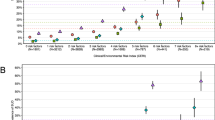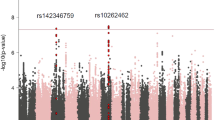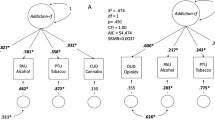Abstract
Childhood maltreatment is considered a risk factor for substance use disorders (SUD), but this is largely based on retrospective self-reports that are subject to recall bias, designs that do not control for familial confounding, or both. The specific contribution of childhood maltreatment to SUD risk thus remains unclear. Here, we evaluated this contribution in a prospective cohort with objectively recorded childhood maltreatment, using a design that allows controlling for familial confounding. We used medical records and registers to study 525 young adults (20–37 years) with prospectively and objectively documented severe maltreatment exposure, 1979 clinical controls (unexposed former child and adolescent psychiatry patients), 1388 matched healthy controls; and their siblings and cousins. We examined the association between maltreatment and SUD using Cox regression models in the population, as well as stratified within siblings in the same family. SUD risk was significantly increased with childhood maltreatment exposure (crude HR: 6.61, 95% CI: 5.81–7.53; HR adjusted for sex, birthyear, externalizing problems, parents’ SUD and socioeconomic factors: 3.50, 95% CI 2.95, 4.16). An approximately threefold elevated SUD risk remained when comparing exposed individuals with their unexposed siblings (adjusted HR: 3.12, 95% CI 2.21, 4.42). We provide estimates of the association between childhood maltreatment and SUD accounting for possible confounds of both recall bias and familial factors. When familial confounding is controlled for, SUD risk attributable to severe childhood maltreatment is decreased, but nevertheless considerable. These findings establish a specific contribution of childhood maltreatment to SUD, underscoring the need for SUD prevention in young people exposed to maltreatment.
This is a preview of subscription content, access via your institution
Access options
Subscribe to this journal
Receive 12 print issues and online access
$259.00 per year
only $21.58 per issue
Buy this article
- Purchase on Springer Link
- Instant access to full article PDF
Prices may be subject to local taxes which are calculated during checkout

Similar content being viewed by others
Change history
30 April 2021
A Correction to this paper has been published: https://doi.org/10.1038/s41380-021-01115-z
References
Huang MC, Schwandt ML, Ramchandani VA, George DT, Heilig M. Impact of multiple types of childhood trauma exposure on risk of psychiatric comorbidity among alcoholic inpatients. Alcohol Clin Exp Res. 2012;36(6):1099–107.
Schwandt ML, Heilig M, Hommer DW, George DT, Ramchandani VA. Childhood trauma exposure and alcohol dependence severity in adulthood: mediation by emotional abuse severity and neuroticism. Alcohol Clin Exp Res. 2013;37(6):984–92.
Kendler KS, Bulik CM, Silberg J, Hettema JM, Myers J, Prescott CA. Childhood sexual abuse and adult psychiatric and substance use disorders in women: an epidemiological and cotwin control analysis. Arch Gen Psychiatry. 2000;57(10):953–9.
Konkoly Thege B, Horwood L, Slater L, Tan MC, Hodgins DC, Wild TC. Relationship between interpersonal trauma exposure and addictive behaviors: a systematic review. BMC Psychiatry. 2017;17(1):164.
Dube SR, Felitti VJ, Dong M, Chapman DP, Giles WH, Anda RF. Childhood abuse, neglect, and household dysfunction and the risk of illicit drug use: the adverse childhood experiences study. Pediatrics. 2003;111(3):564–72.
Hyman SM, Paliwal P, Chaplin TM, Mazure CM, Rounsaville BJ, Sinha R. Severity of childhood trauma is predictive of cocaine relapse outcomes in women but not men. Drug Alcohol Depend. 2008;92(1-3):208–16.
Moustafa AA, Parkes D, Fitzgerald L, Underhill D, Garami J, Levy-Gigi E et al. The relationship between childhood trauma, early-life stress, and alcohol and drug use, abuse, and addiction: an integrative review. Curr Psychol. 2018.
Fergusson DM, Horwood LJ, Woodward LJ. The stability of child abuse reports: a longitudinal study of the reporting behaviour of young adults. Psychol Med. 2000;30(3):529–44.
Colman I, Kingsbury M, Garad Y, Zeng Y, Naicker K, Patten S, et al. Consistency in adult reporting of adverse childhood experiences. Psychol Med. 2016;46(3):543–9.
Widom CS, Morris S. Accuracy of adult recollections of childhood victimization, Part 2: childhood sexual abuse. Psychol Assess. 1997;9(1):34–46.
MacDonald K, Thomas ML, Sciolla AF, Schneider B, Pappas K, Bleijenberg G, et al. Minimization of childhood maltreatment is common and consequential: results from a large, multinational sample using the Childhood Trauma Questionnaire. PloS One. 2016;11(1):e0146058.
Baldwin JR, Reuben A, Newbury JB, Danese A. Agreement between prospective and retrospective measures of childhood maltreatment: a systematic review and meta-analysis. JAMA Psychiatry. 2019;76(6):584–93.
Reuben A, Moffitt TE, Caspi A, Belsky DW, Harrington H, Schroeder F, et al. Lest we forget: comparing retrospective and prospective assessments of adverse childhood experiences in the prediction of adult health. J Child Psychol Psychiatry. 2016;57(10):1103–12.
Widom CS, Weiler BL, Cottler LB. Childhood victimization and drug abuse: a comparison of prospective and retrospective findings. J Consult Clin Psychol. 1999;67(6):867–80.
Widom CS. The cycle of violence. Science. 1989;244(4901):160–6.
Forsman M, Langstrom N. Child maltreatment and adult violent offending: population-based twin study addressing the ‘cycle of violence’ hypothesis. Psychol Med. 2012;42(9):1977–83.
Kendler KS, Prescott CA, Myers J, Neale MC. The structure of genetic and environmental risk factors for common psychiatric and substance use disorders in men and women. Arch Gen Psychiatry. 2003;60(9):929–37.
Walsh C, MacMillan HL, Jamieson E. The relationship between parental substance abuse and child maltreatment: findings from the Ontario Health Supplement. Child Abus Negl. 2003;27(12):1409–25.
Young-Wolff KC, Kendler KS, Ericson ML, Prescott CA. Accounting for the association between childhood maltreatment and alcohol-use disorders in males: a twin study. Psychol Med. 2011;41(1):59–70.
Kendler KS, Baker JH. Genetic influences on measures of the environment: a systematic review. Psychol Med. 2007;37(5):615–26.
Shadish WR, Cook TD, Campbell DT. Experimental and quasi-experimental designs for generalized causal inference. Houghton Mifflin: Boston, 2001, xxi, 623 p.pp.
Lahey BB, D’Onofrio BM. All in the family: comparing siblings to test causal hypotheses regarding environmental influences on behavior. Curr Dir Psychol Sci. 2010;19(5):319–23.
Sjölander A, Frisell T, Kuja-Halkola R, Öberg S, Zetterqvist J. Carryover effects in sibling comparison designs. Epidemiology. 2016;27(6):852–8.
Wirehn AB, Karlsson HM, Carstensen JM. Estimating disease prevalence using a population-based administrative healthcare database. Scand J Public Health. 2007;35(4):424–31.
Ludvigsson JF, Andersson E, Ekbom A, Feychting M, Kim JL, Reuterwall C, et al. External review and validation of the Swedish national inpatient register. BMC Public Health. 2011;11:450.
Ekbom A. The Swedish multi-generation register. Methods Mol Biol. 2011;675:215–20.
Wettermark B, Hammar N, Fored CM, Leimanis A, Otterblad Olausson P, Bergman U, et al. The new Swedish prescribed drug register-opportunities for pharmacoepidemiological research and experience from the first six months. Pharmacoepidemiol Drug Saf. 2007;16(7):726–35.
Ludvigsson JF, Almqvist C, Bonamy AK, Ljung R, Michaelsson K, Neovius M, et al. Registers of the Swedish total population and their use in medical research. Eur J Epidemiol. 2016;31(2):125–36.
Ludvigsson JF, Otterblad-Olausson P, Pettersson BU, Ekbom A. The Swedish personal identity number: possibilities and pitfalls in healthcare and medical research. Eur J Epidemiol. 2009;24(11):659–67.
Arat A, Ostberg V, Burstrom B, Hjern A. ADHD medication in offspring of immigrants—does the income level of the country of parental origin matter? BMC Psychiatry. 2018;18(1):3.
Widom CS, Marmorstein NR, White HR. Childhood victimization and illicit drug use in middle adulthood. Psychol Addict Behav. 2006;20(4):394–403.
Widom CS, White HR, Czaja SJ, Marmorstein NR. Long-term effects of child abuse and neglect on alcohol use and excessive drinking in middle adulthood. J Stud Alcohol Drugs. 2007;68(3):317–26.
Wilens TE, Martelon M, Joshi G, Bateman C, Fried R, Petty C, et al. Does ADHD predict substance-use disorders? A 10-year follow-up study of young adults with ADHD. J Am Acad Child Adolesc Psychiatry. 2011;50(6):543–53.
Groenman AP, Janssen TWP, Oosterlaan J. Childhood psychiatric disorders as risk factor for subsequent substance abuse: a meta-analysis. J Am Acad Child Adolesc Psychiatry. 2017;56(7):556–69.
MacMillan HL, Jamieson E, Walsh CA. Reported contact with child protection services among those reporting child physical and sexual abuse: results from a community survey. Child Abus Negl. 2003;27(12):1397–408.
Regeringskansliet. Social Services Act SFS 2001:453 Socialtjanstlag (SSA) In: Socialdepartementet (ed). Regeringskansliet, http://rkrattsbaser.gov.se/sfst?bet=2001:453: Stockholm, 2001-06-07
Socialdepartementet. Delbetänkande av Missbruksutredningen. - Missbruket, Kunskapen, Vården (SOU 2011:6): Missbruksutredningens forskningsbilaga., 2011.
Bergman D, Hagstrom H, Capusan AJ, Marild K, Nyberg F, Sundquist K, et al. Incidence of ICD-based diagnoses of alcohol-related disorders and diseases from Swedish nationwide registers and suggestions for coding. Clin Epidemiol. 2020;12:1433–42.
Andreasson S, Danielsson AK, Hallgren M. Severity of alcohol dependence in the Swedish adult population: association with consumption and social factors. Alcohol. 2013;47(1):21–25.
Acknowledgements
This study was funded by the Swedish Research Council 2013–2024 Markus Heilig, grant nos. 2013–07434; the Medical Training and Research Agreement in Östergötland Region, grant no. ALF 2017: LIO-599451 main funding recipient Per Gustafsson; ALF 2018: LIO-692621; and ALF 2019: LIO-791581, main funding recipient Andrea J Capusan, and by the Systembolagets alkoholforskningsråd, grant numbers: 2016–0018, 2017–0075, 2018–0030, and 2019–0007 main recipient Markus Heilig. Funding agencies had no role in the design, execution or analysis of this study or preparation of the manuscript. We would like to thank Erik Onelöv, statistician at Region Östergötland Enterprise Business intelligence System (REBUS) for help with data extraction from the regional patient registers.
Author information
Authors and Affiliations
Corresponding authors
Ethics declarations
Conflict of interest
AJC has received speaker’s fees, and/ or scientific advisory board compensation from Lundbeck, Indivior and Camurus, all outside the scope of the current project. MH has received speaker’s fees, research funding and/ or scientific advisory board compensation from Lundbeck, Aelis Farma, Indivior, Brainsway Technologies and Janssen Pharmaceuticals, all outside the scope of current project. PAG has received speaker fees and scientific advisory board compensation from Lilly and Shire pharmaceutical companies all outside the scope of the current project. RK-H, KI, and LMM declares no competing interests.
Additional information
Publisher’s note Springer Nature remains neutral with regard to jurisdictional claims in published maps and institutional affiliations.
Supplementary information
Rights and permissions
About this article
Cite this article
Capusan, A.J., Gustafsson, P.A., Kuja-Halkola, R. et al. Re-examining the link between childhood maltreatment and substance use disorder: a prospective, genetically informative study. Mol Psychiatry 26, 3201–3209 (2021). https://doi.org/10.1038/s41380-021-01071-8
Received:
Revised:
Accepted:
Published:
Issue Date:
DOI: https://doi.org/10.1038/s41380-021-01071-8
This article is cited by
-
Childhood abuse and craving in methamphetamine-dependent individuals: the mediating role of alexithymia
European Archives of Psychiatry and Clinical Neuroscience (2024)
-
Resilience to substance use disorder following childhood maltreatment: association with peripheral biomarkers of endocannabinoid function and neural indices of emotion regulation
Molecular Psychiatry (2023)
-
The mediation role of shame proneness in the association between perceived parenting and the severity of addictive behaviors: risk or protective factor?
Current Psychology (2023)
-
Hazardous drinking and alcohol use disorders
Nature Reviews Disease Primers (2022)



